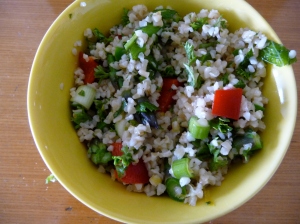 Wondering how to choose and use lemons? Check out Toby’s handy lemon guide — just click here. For lemon recipes, click on the pages above, just below the “lemons, lemons, lemons” title.
Wondering how to choose and use lemons? Check out Toby’s handy lemon guide — just click here. For lemon recipes, click on the pages above, just below the “lemons, lemons, lemons” title.
Your guide to lemons
The lemon caves of Cappadocia, Turkey
 Cappadocia, a region in the Central Anatolia, Turkey, is an area of other-worldly rock formations, fairy chimneys, ancient underground cities and Byzantine cave churches.
Cappadocia, a region in the Central Anatolia, Turkey, is an area of other-worldly rock formations, fairy chimneys, ancient underground cities and Byzantine cave churches.
 We had visited many of these fascinating sites over three days in the area when I happened upon a guide book describing yet another use for these natural caves, with their consistently moderate temperatures: storing lemons (and sometimes other produce, such as potatoes).
We had visited many of these fascinating sites over three days in the area when I happened upon a guide book describing yet another use for these natural caves, with their consistently moderate temperatures: storing lemons (and sometimes other produce, such as potatoes).
 I persuaded our generous host, Okan Yazgan (from Aravan Evi) , to take me to see one of these lemon storage caves, and he kindly agreed to drive us to Ortahisar, where many of these caves are located. He stopped to ask a student, returning home after school, where we might find one of these caves. (Thank you, Okan, for taking me on this important lemon quest!)
I persuaded our generous host, Okan Yazgan (from Aravan Evi) , to take me to see one of these lemon storage caves, and he kindly agreed to drive us to Ortahisar, where many of these caves are located. He stopped to ask a student, returning home after school, where we might find one of these caves. (Thank you, Okan, for taking me on this important lemon quest!)
 The entrance to the lemon storage cave, beneath some farmland, was quite indistinct, and nearly impossible to see from the road nearby. It seemed like a secret cave.
The entrance to the lemon storage cave, beneath some farmland, was quite indistinct, and nearly impossible to see from the road nearby. It seemed like a secret cave.
 It was a hot day, but the cave was cool and dark, with strings of electric lights illuminating an amazing scene: piles of lemon boxes stacked to the rock ceiling, women in headscarves packing the lemons into boxes.
It was a hot day, but the cave was cool and dark, with strings of electric lights illuminating an amazing scene: piles of lemon boxes stacked to the rock ceiling, women in headscarves packing the lemons into boxes.
 The lemons are not grown here, but are shipped from the coast and stored here for about five months before being sent to a plant for more cleaning, sorting and packing before sale. There are about 600 or 700 such caves in Cappadocia, the foreman told us.
The lemons are not grown here, but are shipped from the coast and stored here for about five months before being sent to a plant for more cleaning, sorting and packing before sale. There are about 600 or 700 such caves in Cappadocia, the foreman told us.
 Eventually the lemons, known as “Yatak,” are sold to Russia, Georgia, Iraq and Europe.
Eventually the lemons, known as “Yatak,” are sold to Russia, Georgia, Iraq and Europe.
 It looks like the lemon-packers could bring their children with them to the job.
It looks like the lemon-packers could bring their children with them to the job.
 Ventilation holes had been drilled into the cave’s ceiling.
Ventilation holes had been drilled into the cave’s ceiling.
 Up above the cave, in an orchard, were the chimneys for ventilation — about the only surface sign of the activity below!
Up above the cave, in an orchard, were the chimneys for ventilation — about the only surface sign of the activity below!
 I’d never heard of lemons being stored in caves, but it makes sense, as the temperature is so consistent. I just keep finding out more and more about those fascinating lemons!
I’d never heard of lemons being stored in caves, but it makes sense, as the temperature is so consistent. I just keep finding out more and more about those fascinating lemons!
Filed under lemons
Turkish lemons, Egyptian “lemon squeezers”
 I just keep learning new things about lemons. On my recent trip to Turkey, I visited Alacati, on the Çesme peninsula of the Aegean Coast, and there I was introduced to a special kind of lemon called Çesme lemons.
I just keep learning new things about lemons. On my recent trip to Turkey, I visited Alacati, on the Çesme peninsula of the Aegean Coast, and there I was introduced to a special kind of lemon called Çesme lemons.
The Çesme lemon is much like a lemon from the Amalfi Coast: the rind and albedo (pith) are both slightly sweet, and the lemon pulp is less acid than a normal lemon — which means you can eat the whole lemon, peel and all. (Well, at least I can. And, no, I wouldn’t do that with a normal lemon.)
 The Çesme lemon is also BIG. In the photo, I’m holding a normal-size lemon in my left hand (also from Turkey), and the Çesme lemon is on the right.
The Çesme lemon is also BIG. In the photo, I’m holding a normal-size lemon in my left hand (also from Turkey), and the Çesme lemon is on the right.

Some fish restaurants in Turkey tie netting over the lemon halves so you can squeeze the juice without getting the seeds.
Okay, what’s this about Egyptian lemon squeezers?
In Thomas Friedman’s New York Times’ column about life and politics in Egypt (June 16, 2013), he explains an Egyptian expression: “when you are forced to do or eat something unpleasant you say: ‘I squeezed lemon all over it first.'” (Friedman says that non-Islamists who voted for President Morsi of the Muslim Brotherhood are referred to as “lemon squeezers.”)
In other words, lemon juice makes everything more palatable.
What’s so interesting about this expression is that it’s the opposite of our “when life gives you lemons, make lemonade” saying, which implies that sugar is needed to make lemons themselves palatable. In the Egyptian expression, it’s the lemons that are valuable. No sugar added.
Stay tuned for more about lemons in Turkey — the lemon storage caves of Cappadocia!
More lemon pizza
Zak reported that he and Tara created another great version of the lemon pizza I wrote about earlier (the one with the smoked mozarella).
This “slim pickings” rendition, born of having few ingredients to put on the pizza dough, uses a base of pesto (or oil and garlic), one whole Meyer lemon sliced paper thin, a handful of parsley minced, 3 tablespoons capers sprinkled on top, and then feta and mozzarella cheese, he says.
As Zak says, “It was very good. . . .”
I tried it out and can testify: this is a great combination. It’s kind of like a deconstructed gremolata. It will make your mouth water with the tart lemon and the salty capers. Yum.
Filed under lemons
Triple lemon bulgur salad
The other day I made some of my go-to salad, a lemony salad of bulgur wheat, parsley and mint, green onion and vegetables — whatever is in season or tempting — all perked up by a dressing of lemon, olive oil, garlic and lemon zest. The version above was a simple one with the addition of chopped raw red pepper and pieces of cooked asparagus.
Inspired by tabbouleh, this salad relies on lemon three times: the lemon juice added to the water for soaking the bulgur, and the dressing with both lemon juice and lemon peel. (You’ll need about 2 medium to large lemons for the salad).
The recipe is infinitely adaptable, as you can substitute other cooked grains – rice, barley, quinoa, etc. – for the bulgur, use different combinations of herbs (cilantro, dill?), vary the vegetables (raw, cooked or roasted) to the season or your taste, add feta or goat cheese, chicken or fish, olives or nuts. Even fruit (fresh or dried). In Ripe, Nigel Slater offers a tabbouleh with fresh plums or peaches, which is quite delicious. I often add crumbled feta cheese and kalamata olives to my mix — and sometimes walnuts too.
The salad is great for a picnic, light lunch or side dish.
Here are the basic ingredients – take it from here!
Triple Lemon Bulgur Salad
- 1 cup bulgur
- I cup boiling water
- 2 tablespoons lemon juice
- 1 teaspoon salt
- I bunch green onions, whites and part of the greens, chopped
- 1 bunch parsley, finely chopped
- I small bunch of mint, finely chopped (or 2 teaspoons dried mint. Or both)
- Zest of one lemon, finely grated
- Vegetables, such as chopped red pepper, cherry tomato halves, roasted cauliflower, cooked green beans, asparagus, etc.
- Optional: garbanzo beans or white beans, sliced kalamata olives, feta cheese, walnuts, sesame seeds, etc.
- Salt and pepper to taste
Dressing:
- ¼ cup (4 tablespoons) olive oil
- ¼ cup (4 tablespoons) lemon juice
- 1 clove garlic, minced or pressed in garlic press
-
Put the dry bulgur in a bowl, add the salt, pour the boiling water and lemon juice over the bulgur and cover. Let stand for 30 to 40 minutes until all the liquid is absorbed; then fluff with a fork.
-
Add the chopped green onions, parsley, mint and lemon zest to the bulgur and combine
-
Combine the olive oil and lemon juice in a small bowl and whisk to emulsify. Pour 6 tablespoons of the dressing over the bulgur mixture, reserving the other two tablespoons to use if you want the salad to be moister.
-
Add vegetables, beans, nuts, olives or other ingredients as you see fit and mix. Add more of the dressing if you think it needs it; salt and pepper (and more mint) to taste.
Filed under lemons
Preserving lemons, part 2

Well, it seemed extravagant to actually dehydrate lemons, as I usually just have enough lemons for all the fresh uses I have for them. But since I’d been given bags and boxes of lemons in California, I decided I could spare a few for this experiment.
I put the thinly cut slices on my food dehydrator and set it at 135 degrees.
Between six and eight hours later, they were dry.
They’re handy for travel when lemons aren’t always available, especially added to a beverage — water or hot tea. Or you could string them up for decorations……They really are quite lovely.
Filed under food, lemons, preserved lemons
Preserving lemon

Diana Henry’s recipe for pickled lemons calls for thinly sliced lemons, with coarse salt and paprika sprinkled between each layer. Wait three weeks before eating.
Winter is a great time to be preserving lemons and I’ve seen some nice blogs lately with good ideas on how to do that. I’ve mentioned lemon sugar but Emmy takes the concept further with her tribute to citrus sugar here.
And the Food in Jars blog has a wonderful post called “Eight Ways to Preserve Meyer Lemons.” Even if you don’t have Meyers around, most of these recipes would adapt well to what we might call regular lemons … or real lemons (not the kind in the plastic container!) as Meyers are actually a hybrid citrus. Just remember that a regular lemon will be more sour than a Meyer — if you want to replicate the sweetness of Meyer lemon juice, for example, you could use equal proportions of fresh lemon and orange juice. I haven’t tried dehydrating lemons yet — that’s my next project!
Filed under lemons, Meyer lemons, preserved lemons
Lemon pizza!
This lemon pizza is really a keeper — I wrote a post about it recently on my kitchen blog. And, if you have any pizza dough you like, it’s really simple.
Just take a few lemons, slice them thinly (cut the rounds in half or not, as you like) and soak in water for 15 minutes, then pat dry.
Layer slices of smoked mozzarella on the crust, then top with the lemon slices and tuck in whole leaves of basil. Drizzle everything generously with olive oil and bake in a very hot oven until it’s done to your liking. Zak uses a pizza stone (which he buys inexpensively at a ceramics supply) and it is great.
If you like lemons (I know you do!) you’ll love this. The balance of the crust, the smoky cheese and the tart snap of lemon is fantastic.
Filed under lemons
All about lemons at Elliott Bay Book Company, Seattle, this Sunday
Please join me (and bring your friends!) at Elliott Bay Books, 1521 Tenth Avenue, Seattle, on Sunday, Nov. 4 at 2 p.m. for an illustrated talk about the fascinating history of the lemon.
Lemon: A Global History tells the story of the remarkable adventure of the lemon, starting with its fragrant and mysterious ancestor, the citron, adored by the Greeks and Romans for its fine perfume and sacred to many of the world’s great religions. The lemon traveled with Arabs along ancient trade routes, came of age in Sicily and Italy, and sailed to the New World with Columbus.
It was an exotic luxury in seventeenth-century Europe and later went on to save the lives of thousands of sailors in the British Royal Navy after being recognizedas a cure for scurvy. The last century saw the lemon rise to commercial success, along with Sunkist and a California citrus empire, and the discovery of the Meyer lemon by the eccentric plant explorer Frank Meyer.
You’ll learn about these highlights and more, all richly illustrated, in Toby’s presentation, with plenty of time for questions and signing afterwards.
Read a Q & A with Toby about the book here or see Toby’s lemon blog.
Bellingham friends: I will be signing books at Pacific Chef in Fairhaven on Saturday, Dec. 1, from 11 to 3!
Filed under lemons












